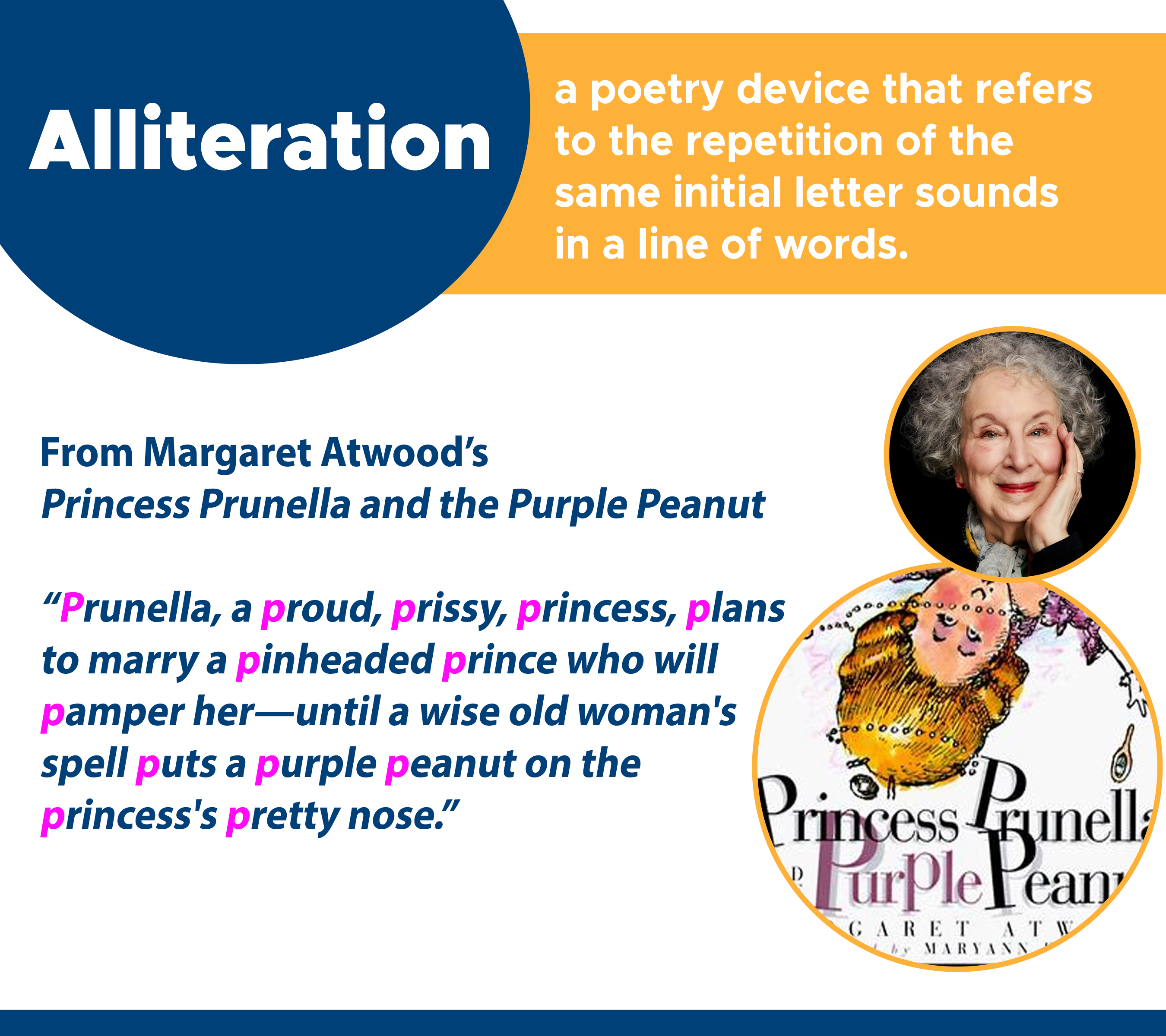What is Alliteration?
Also called head rhyme or initial rhyme, alliteration is a poetry device that refers to the repetition of the same initial letter sounds in a line of words. In alliteration, you’ll hear the initial sounds run smoothly from one word to another. Try reading these phrases aloud: “femme fatale,” “pretty in pink,” “white wine,” and “love locks.”
Alliteration creates rhythm and mood, helping the readers memorize a piece or recite it for fun. Notice how the roll of r sounds in “the robot rides the rocket ship” also sounds like a roaring engine – something closely related to the meaning of the sentence. Alliteration in the form of tongue twisters can even serve as a speech exercise: “She sells seashells by the seashore.”
To be clear, alliteration is the repetition of sounds, not only letters. “Car chase” is not alliterative even when its words have the same initial letters. “Kate’s cookies” is alliterative because Kate and cookies share the same initial hard “k” sound. Note that words don’t need to be next to one another to qualify as alliterative.

More Examples:
- Charlie loves chocolate chips.
- Suzy’s shampoo came from Sally.
- Her mystery man gave her a message.
- This pandemic will be a painful part of the past.
Related Reading: Personification – Humanizing Nonliving Things
Alliteration in Real Life
Pop Culture:
Writers, advertisers, filmmakers, and poets use alliteration to grab readers’ and viewers’ attention. From brand names to movie titles and character names, repetition of sounds is one easy way to achieve recall. Kids can attest to alliteration’s success. Here are some examples of alliteration in cartoon character names and titles of children’s movies.
- Willie Wonka
- Peppa Pig
- Peter Pan
- The Princess and the Pauper
- Beauty and the Beast
- Dr. Dolittle
- Ella Enchanted
- Horton Hears a Who!
More examples of movies and characters with alliterative names:
- Mamma Mia!
- Walter White (Breaking Bad)
- Jessica Jones (The Defenders)
- The Fast and the Furious
- The Pink Panther
- Bruce Banner (The Hulk)
- Peter Parker (Spider-man)
- Steven Stranger (Doctor Strange)
- Wade Winston Wilson (Deadpool)
- Pepper Potts
Examples of alliteration in brand and company names:
- Krispy Kreme
- American Airlines
- Bath & Body Works
- Gorilla Glue
- Red Ribbon
Speech and Literature:
Alliteration bears the mood of a poem and adds depth to its meaning. When read aloud, alliterative words convey the emotions enclosed in the writer’s piece. Here are some examples of alliteration in speech and literature:
- From I have a Dream by Martin Luther King Jr.:
Five score years ago, a great American, in whose symbolic shadow we stand today, signed the Emancipation Proclamation.
MLK’s historic speech used alliteration to stress the immense importance of signing the Proclamation.
- From When Love Arrives by Sarah Kaye & Phil Kay:
Love arrives exactly when love is supposed to,
And love leaves exactly when love must.
When used well, alliteration turns poetry into a beautiful music. The repetition of the “l” sound in this spoken word poem leaves the audience with a memorable love lesson.
- From Macbeth by William Shakespeare:
Fair is foul and foul is fair
Hover through the fog and filthy air
The “f” sound forges an image of a filthy place one needs to endure.
- From Princess Prunella and the Purple Peanut by Margaret Atwood:
Prunella, a proud, prissy, princess, plans to marry a pinheaded prince who will pamper her—until a wise old woman’s spell puts a purple peanut on the princess’s pretty nose.
With Atwood’s excellent use of alliteration, her children stories jump off the pages and fall into the readers’ imaginative minds. This book’s repetition of the p sound helps kids to easily read, understand, and feel the story.
What is the Difference between Alliteration, Assonance, Consonance?
While they’re all literary devices that use repetition of sounds, alliteration differs from assonance and consonance. Remember that alliteration repeats initial letter sounds; assonance and consonance are not limited to the initial sounds. Assonance or “vowel” rhyme is the repetition of vowel sounds that can appear anywhere across connected texts. Notice the “o” sound in “The boy sold his old toys” and the “e” sound in Emma resembles Rachel’s endearing eyes. In contrast to assonance, consonance is the repetition of consonant sounds across connected texts. Examples are “The Mad Hatter was rattled by Alice’s tale” and “She saw the ashes rise.”
Thank you for reading. We hope it’s effective! Always feel free to revisit this page if you ever have any questions about alliteration.

